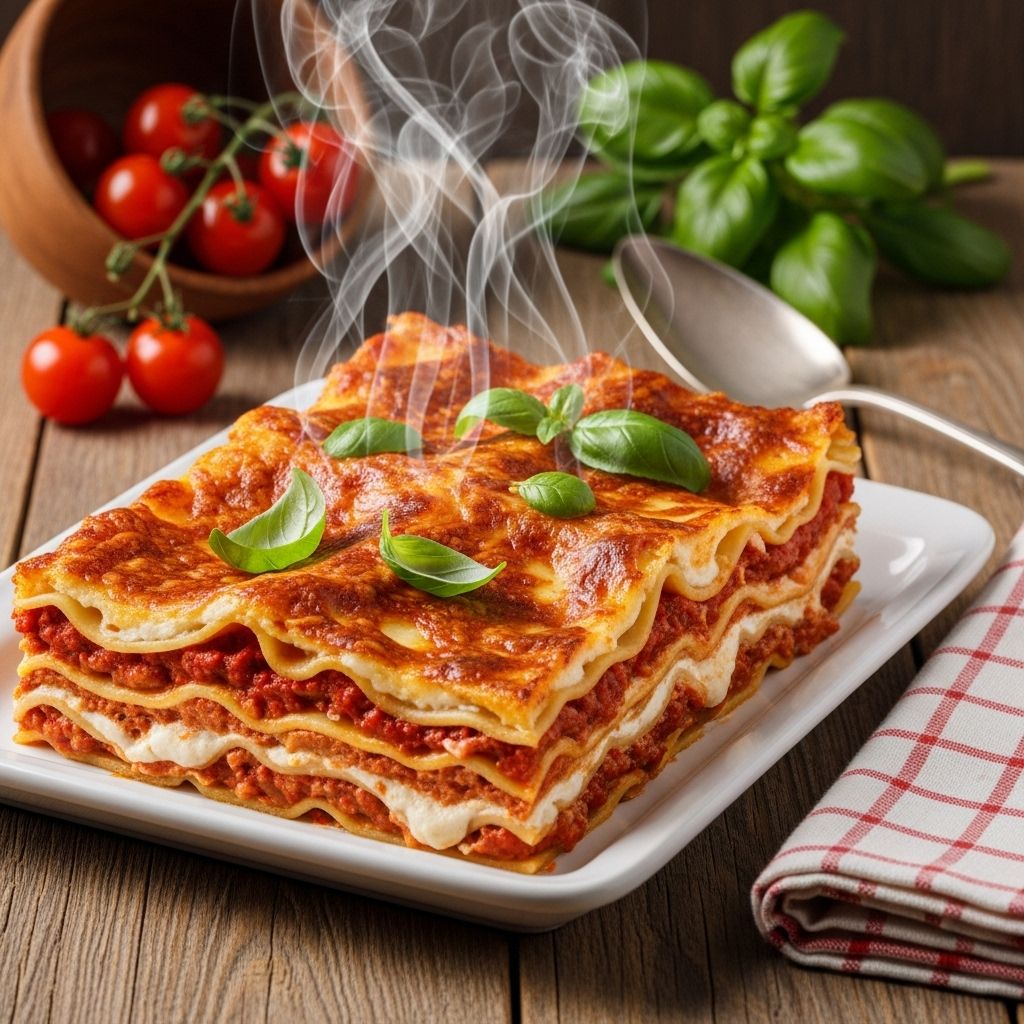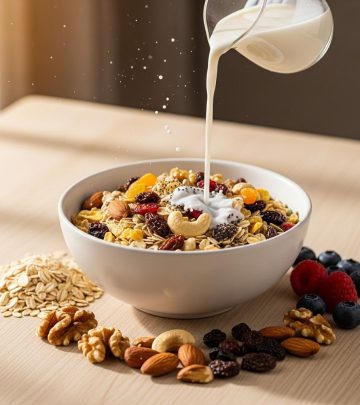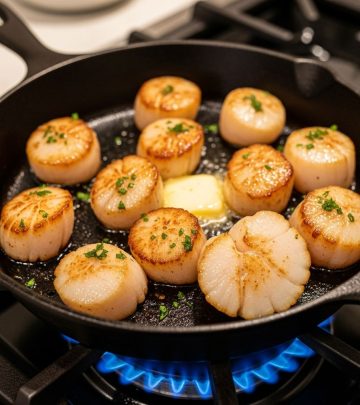Classic Italian Lasagna: The Ultimate Home-Cooked Comfort
Delight in layer upon layer of rich meat sauce, creamy béchamel, and tender pasta in this traditional Italian lasagna recipe.

Classic Italian Lasagna by Giada De Laurentiis
Lasagna is the backbone of traditional Italian comfort food, beloved for its hearty layers of tender pasta, decadent meat sauce, creamy béchamel, and melted cheese. This guide walks you through each component and step—from prepping the sauces to assembling and baking—ensuring a spectacular home-cooked result every time.
Table of Contents
- Introduction
- Ingredients
- Preparing the Meat Sauce
- Making the Béchamel Sauce
- Preparing the Ricotta Mixture
- Lasagna Assembly
- Baking Instructions
- Serving Suggestions
- Expert Tips and Variations
- Frequently Asked Questions
Introduction: The Heart of Italian Cuisine
Lasagna’s allure lies in its
combination of savory meat, creamy cheese, delicate pasta, and a golden, bubbling top
. This recipe, inspired by Italian culinary traditions, showcases not just flavor but also the resourceful layering techniques passed down through generations. With a little advanced prep, anyone can conquer this impressive dish for cozy family dinners or festive gatherings.Ingredients
For a classic Italian lasagna, the ingredient list is simple but distinct—each plays an essential role in building the final layers of flavor.
- Lasagna sheets (no-boil or traditional dried, see tips below)
- Ground beef, providing the main protein base and savoriness
- Whole milk ricotta cheese for creamy, rich layers
- Eggs to bind the ricotta mixture
- Parmigiano-Reggiano cheese, freshly grated for intense salty flavor
- Unsalted butter, key for both béchamel sauce and dotting over the top
- All-purpose flour, to thicken the béchamel
- Whole milk as the base of the béchamel sauce
- Olive oil for browning the meat
- Kosher salt and fresh black pepper for seasoning
- Optional: a pinch of freshly grated nutmeg for béchamel
Preparing the Meat Sauce
Step 1: Heat a pan with a drizzle of olive oil over medium-high heat. Add roughly 1 pound of ground beef.
- Break up the beef with a spatula while still raw; it’s much easier and yields a finer texture.
- Season with kosher salt and pepper immediately to bring out the meat’s natural flavors.
- Sauté until browned and fully cooked, about 4–5 minutes.
Tip: Use a wooden spoon or heatproof spatula to break up the meat thoroughly, ensuring even cooking and bite-sized pieces in every lasagna forkful.
Making the Béchamel Sauce
Béchamel is a hallmark of classic Italian lasagna, adding a velvety, luscious layer amid the savory components.
- In a saucepan, melt 5 tablespoons unsalted butter over medium heat. Once bubbling, add 1/2 cup all-purpose flour and whisk until smooth, about 2 minutes (the mixture should be pale and foamy but not browned).
- Gradually pour in 4 cups whole milk (at room temperature), whisking constantly to avoid lumps. Continue to whisk until the mixture is creamy and thickened, about 5–8 minutes.
- Season with a pinch of salt, fresh black pepper, and optionally, a touch of freshly grated nutmeg for subtle warmth.
- Set aside to cool slightly—the sauce should coat the back of a spoon and flow smoothly (not runny).
Pro Tip: If the béchamel forms lumps, run it through a fine mesh sieve or blend briefly to restore its silky texture.
Preparing the Ricotta Mixture
While your sauces cool, prepare the ricotta filling to infuse creaminess and structure into every bite.
- In a large bowl, beat 3 large eggs until frothy.
- Add 1 1/2 pounds whole milk ricotta cheese and a sprinkle of salt. Gently fold to combine—the eggs should disappear entirely for a unified, creamy filling.
The result: A light, slightly custardy mixture that cooks up fluffy in the oven, balancing out the hearty meat and rich sauce.
Lasagna Assembly
With each separate element ready, it’s time to layer them into a harmonious whole. The order and care you take here shapes the final taste, texture, and structure of your lasagna.
- Preheat your oven to 375°F (190°C).
- Spread about 1/3 cup béchamel sauce across the bottom of a deep 9×13-inch baking dish. This provides a moist base to soften the first pasta layer.
- Arrange no-boil lasagna sheets (or parboiled traditional sheets) evenly in a single layer, slightly overlapping.
- Spoon and spread half the ricotta mixture evenly across the noodles.
- Scatter
half the cooked beef
over the ricotta. - Drizzle or spread about 1/3 of the remaining béchamel sauce over the meat layer.
- Sprinkle
grated Parmigiano-Reggiano cheese
for even more savory lift. - Repeat the pasta, ricotta, beef, béchamel, and cheese layering one more time.
- For the final layer, finish with a last sheet of pasta, drizzle of béchamel, and a generous blanket of grated Parmigiano-Reggiano.
- Dot the top with 2 tablespoons unsalted butter, breaking it into small pieces to melt and encourage browning and a crisp crust.
Assembly Order Table:
| Layer | Ingredients |
|---|---|
| 1 (Bottom) | Béchamel |
| 2 | Lasagna Sheets |
| 3 | Ricotta Mixture |
| 4 | Cooked Meat |
| 5 | Béchamel + Parmesan |
| 6-8 | Repeat Layers |
| Final | Pasta Sheets, Remaining Béchamel, Parmesan, Dotted Butter |
Baking Instructions
- Cover the assembled lasagna loosely with foil, tenting it to prevent sticking. Place in the preheated oven.
- Bake for 40–45 minutes. The lasagna is ready when the top is golden brown, bubbling at the edges, and the pasta is tender throughout.
- For extra browning: Remove the foil for the last 10 minutes of baking.
- Let lasagna rest for 15–20 minutes before slicing. Resting ensures the layers set and slices hold their shape beautifully.
Serving Suggestions
This lasagna, when sliced, reveals beautiful strata of sauce, cheese, and beef. Serve portions with:
- Fresh basil or chopped Italian parsley for brightness
- A crisp green salad lightly dressed with vinaigrette
- Rustic bread for sopping up extra béchamel and sauce
- A robust Italian red wine, such as Chianti
Expert Tips and Variations
- Plan Ahead: Prepare sauces and filling up to a day in advance. Lasagna can also be assembled and refrigerated overnight before baking, allowing flavors to meld.
- No-Boil vs. Traditional Pasta: No-boil sheets save time and absorb sauces well, but traditional pasta (cooked al dente) provides a chewier bite. Both work wonderfully—just don’t overlap layers too much.
- Vegetarian Variation: Substitute ground beef with sautéed mushrooms, zucchini, spinach, or roasted bell peppers for a hearty meatless option.
- Make-Ahead: Assemble, cover, and refrigerate for up to 24 hours before baking. You can also freeze baked or unbaked lasagna for up to 2 months (thaw before reheating or baking).
- Cheese Choices: While Parmigiano-Reggiano is traditional, feel free to add mozzarella or pecorino for extra richness.
- Personalized Touches: Add a pinch of dried Italian herbs to the beef, or a splash of tomato paste for a deeper sauce.
Frequently Asked Questions (FAQs)
Q: Can I make the entire lasagna ahead of time?
A: Yes. Assemble up to a day ahead and keep refrigerated or freeze for longer storage. Add an extra 10-15 minutes to the bake time if starting from cold.
Q: Do I really need both ricotta and béchamel?
A: For classic Italian flavor and texture, yes. Béchamel brings silkiness, while ricotta ensures a tender, creamy layer.
Q: What if I use oven-ready lasagna noodles?
A: No problem. Oven-ready sheets are designed to absorb moisture as the lasagna bakes; just be sure your sauces are not too thick or dry.
Q: Can I substitute ground turkey or pork for the beef?
A: Absolutely. Use any ground meat, or a mix, adjusting the seasoning to complement the chosen protein.
Q: How should I reheat leftover lasagna?
A: Cover and gently warm in a 350°F (175°C) oven until hot throughout, or microwave individual slices, covering them to retain moisture.
Classic Italian Lasagna: Final Thoughts
Mastering lasagna is about patience, care, and quality ingredients. Follow these steps to create a dish that not only dazzles on special occasions but also comforts on quiet weeknights. Whether you’re introducing a slice to lasagna newcomers or rekindling childhood nostalgia, this classic recipe brings everyone to the table—hungry for more.












